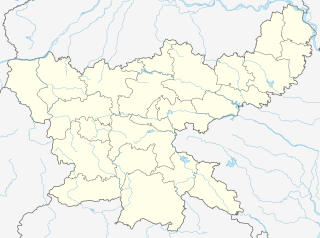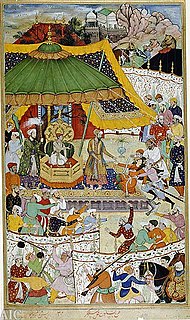
Muslin is a cotton fabric of plain weave. It is made in a wide range of weights from delicate sheers to coarse sheeting. It gets its name from the city of Mosul, Kurdistan, where it was first manufactured. In the 17th and 18th centuries Dacca in Bengal was regarded as producing the finest muslins.

Qutb-ud-Din Muhammad Azam, commonly known as Azam Shah, was briefly the Mughal emperor, who reigned from 14 March 1707 to 20 June 1707. He was the Third son of the sixth Mughal emperor Aurangzeb and his chief consort Dilras Banu Begum.

Jamdani is a fine muslin textile produced for centuries in South Rupshi of Narayanganj district in Bangladesh on the bank of Shitalakhwa river. The historic production of jamdani was patronized by imperial warrants of the Mughal emperors. Under British colonialism, the Bengali jamdani and muslin industries rapidly declined due to colonial import policies favoring industrially manufactured textiles. In more recent years, the production of jamdani has witnessed a revival in Bangladesh. Jamdani is typically woven using a mixture of cotton and gold thread.

The Bengal Presidency, officially the Presidency of Fort William and later Bengal Province, was a subdivision of the British Empire in India. At the height of its territorial jurisdiction, it covered large parts of what is now South Asia and Southeast Asia. Bengal proper covered the ethno-linguistic region of Bengal. Calcutta, the city which grew around Fort William, was the capital of the Bengal Presidency. For many years, the Governor of Bengal was concurrently the Viceroy of India and Calcutta was the de facto capital of India until 1911.

Rajmahal is a subdivisional town and a notified area in Rajmahal subdivision of the Sahibganj district in the Indian state of Jharkhand. It is situated at the banks of Ganges and was former capital of Bengal Subah under Mughal governor, Man Singh I.
'India' was the one of the largest economies in the world for most of the next two and a half millennia, starting around the end of 1st millennium BCE and ending around the beginning of British rule in India.

The history of Bengal is intertwined with the history of the broader Indian subcontinent and the surrounding regions of South Asia and Southeast Asia. It includes modern-day Bangladesh and the Indian states of West Bengal and Assam's Karimganj district, located in the eastern part of the Indian subcontinent, at the apex of the Bay of Bengal and dominated by the fertile Ganges delta. The advancement of civilisation in Bengal dates back four millennia. The region was known to the ancient Greeks and Romans as Gangaridai, a powerful kingdom whose elephant forces led the withdrawal of Alexander the Great from Eastern India. The Ganges and the Brahmaputra rivers act as a geographic marker of the region, but also connects the region to the broader Indian subcontinent. Bengal, at times, has played an important role in the history of the Indian subcontinent.

The Nawab of Bengal was the hereditary ruler of Bengal Subah in Mughal India. The Nawab of a princely state or autonomous province is comparable to the European title of Grand Duke. In the early 18th-century, the Nawab of Bengal was the de facto independent ruler of the three regions of Bengal, Bihar, and Orissa which constitute the modern-day sovereign country of Bangladesh and the Indian states of West Bengal, Bihar and Orissa. They are often referred to as the Nawab of Bengal, Bihar and Orissa. The Nawabs were based in Murshidabad which was centrally located within Bengal, Bihar, and Orissa. Their chief, a former prime minister, became the first Nawab. The Nawabs continued to issue coins in the name of the Mughal Emperor. But for all practical purposes, the Nawabs governed as independent monarchs. Bengal continued to contribute the largest share of funds to the imperial treasury in Delhi. The Nawabs, backed by bankers such as the Jagat Seth, became the financial backbone of the Mughal court. During the 18th-century, the Nawabs of Bengal were among the wealthiest rulers in the world.

Alivardi Khan was the Nawab of Bengal from 1740 to 1756. He toppled the Nasiri dynasty of Nawabs and assumed power himself. He is also known for his victory during the Battle of Burdwan against the Maratha Empire during the Maratha invasions of Bengal.
The Maratha invasions of Bengal (1741-1751), also known as the Maratha expeditions in Bengal, refers to the frequent invasions by the Maratha forces in the Bengal Subah, after their successful campaign in the Carnatic region at the Battle of Trichinopoly. The leader of the expedition was Maratha Maharaja Raghoji Bhonsle of Nagpur. The Marathas invaded Bengal six times from August 1741 to May 1751. Nawab Alivardi Khan succeeded in resisting all the invasions in western Bengal, however, the frequent Maratha invasions caused great destruction in the western Bengal Subah, resulting in heavy civilian casualties and widespread economic losses.

The Mughal, Mogul or Moghul Empire, was an early modern empire in South Asia. For some two centuries, the empire stretched from the outer fringes of the Indus basin in the west, northern Afghanistan in the northwest, and Kashmir in the north, to the highlands of present-day Assam and Bangladesh in the east, and the uplands of the Deccan plateau in south India.

The Bengal Subah, also referred to as Mughal Bengal, was the largest subdivision of the Mughal Empire encompassing much of the Bengal region, which includes modern Bangladesh and the Indian state of West Bengal, between the 16th and 18th centuries. The state was established following the dissolution of the Bengal Sultanate, a major trading nation in the world, when the region was absorbed into one of the gunpowder empires. Bengal was the wealthiest region in the Indian subcontinent, and its proto-industrial economy showed signs of driving an Industrial revolution.

Tant sari is a traditional Bengali sari, originating from the Bengal region in the eastern part of the Indian subcontinent, and usually used by Bengali women. It is traditionally made by the weavers from almost all over Bangladesh and the Indian states of West Bengal, Tripura, and Assam's Barak Valley, but typically few places like Dhaka, Tangail, Narayanganj of Bangladesh and Murshidabad, Nadia, Hooghly of West Bengal are famous for tant sari weaving. Tant sari are woven from cotton threads and distinguished by its lightness and transparency. It is considered to be the most comfortable sari for the hot and humid climate in the Indian subcontinent.

Muslin, a cotton fabric of plain weave, was hand woven in the region around Dhaka, Bengal, and exported to Europe, the Middle East, and other markets, for much of the 17th and 18th centuries.

Nawazish Muhammad Khan, also known as Mirza Muhammad Raza, was a Mughal aristocrat and the deputy governor of Dhaka in the 18th century.
Khasa was a high-quality variety of calico cloth that was manufactured and used for clothing in the Mughal Empire.

Piece goods were the textile materials sold in cut pieces as per the buyer's specification. The piece goods were either cut from a fabric roll or produced with a certain length, also called yard goods. Various textiles such as cotton, wool, silk, etc., were traded in terms of piece goods. The prices were determined as per the fabric quality.

Mughal karkhanas were the manufacturing houses and workshops for craftsmen, established by the Mughals in their empire. Karkhana is a Hindustani language word that means factory. These karkhanas were small manufacturing units for various arts and crafts as well as for the emperor's household and military needs. karkhanas were named and classified based on the nature of the job. For example, 'Rangkhana' and 'Chhapakhana' were for textile dyeing and printing work. The term 'tushak-khana' was used to describe workshops that made shawls and embellished them with embroidery or needlework. Imperial or Royal Karkhanas were for luxury goods and weapons. The karkhanas were the place for various production activities and also for the exploration of new techniques and innovations. Some operations such as weaving, embroidery work, and brocade work were often done under one roof, resembling an integrated assembly line.

Jhuna was a fine sheer fabric, an open-weave structure similar to gauze. Jhuna was used primarily in the dresses of the dancers. It was another kind of fine muslin produced in Bengal with other peers such as Buddun khas, kumees, Rang.

Abrawan (āb-i-ravān) was a kind of muslin cloth produced in Indian subcontinent. The Abrawan was characterized by the nature of the fabric that was like flowing water.
















